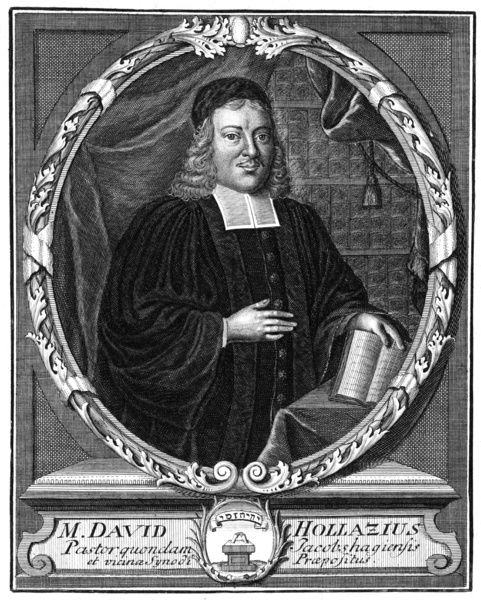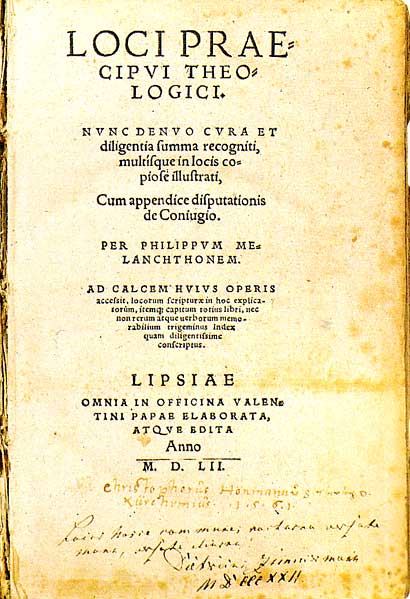|
David Hollatz (writer)
David Hollatz (the younger) (1704 – 14 June 1771) was a German Lutheran minister grandson of the dogmatician David Hollatz. He was preacher at Güntersberg, near Zachan, in Pomerania from 1730 till his death. After a controversy between Hollatz and Siegmund Jakob Baumgarten of Halle orthodox Lutherans looked upon him with disfavor. He steadily receded more and more from the church doctrines and adopted the views of the Moravians Moravians ( cs, Moravané or colloquially , outdated ) are a West Slavic ethnographic group from the Moravia region of the Czech Republic, who speak the Moravian dialects of Czech or Common Czech or a mixed form of both. Along with the Silesi ..., among whom he found greater sympathy. Works He wrote devotional books which were much read and translated (e.g., ''Gebahnte Pilgerstrasse nach dem Berge Zion'', Basel, 1866; ''Evangelische Gnadenordnungen'', Basel, 1894; Eng. transl., ''The Order of Evangelical Grace in the Economy of Salvation'', Lo ... [...More Info...] [...Related Items...] OR: [Wikipedia] [Google] [Baidu] |
Lutheranism
Lutheranism is one of the largest branches of Protestantism, identifying primarily with the theology of Martin Luther, the 16th-century German monk and Protestant Reformers, reformer whose efforts to reform the theology and practice of the Catholic Church launched the Reformation, Protestant Reformation. The reaction of the government and church authorities to the international spread of his writings, beginning with the ''Ninety-five Theses'', divided Western Christianity. During the Reformation, Lutheranism became the state religion of numerous states of northern Europe, especially in northern Germany, Scandinavia and the then-Livonian Order. Lutheran clergy became civil servants and the Lutheran churches became part of the state. The split between the Lutherans and the Roman Catholics was made public and clear with the 1521 Edict of Worms: the edicts of the Diet (assembly), Diet condemned Luther and officially banned citizens of the Holy Roman Empire from defending or propagatin ... [...More Info...] [...Related Items...] OR: [Wikipedia] [Google] [Baidu] |
David Hollatz (dogmatician)
David Hollatz ( Wulkow, near Stargard (34 km ESE of Stettin), in Pomerania, 1648 - Jakobshagen (24 km E of Stargard) 17 April 1713) was a German Lutheran theologian. He studied at Erfurt and Wittenberg, and became preacher at Pützerlin near Stargard in 1670, at Stargard in 1681 (in 1683 also conrector), rector in Colberg in 1684, and pastor in Jakobshagen in 1692. Works His principal work is his ''Examen theologicum acroamaticum'' (Rostock - afterward Stockholm - and Leipzig, 1707; 7th and 8th eds. by Romanus Teller, 1750 and 1763). The work is the last of the strict Lutheran systems of dogmatics in the era of Lutheran orthodoxy. Hollatz knows Pietism, but does not mention it, although he refutes mysticism. The system is divided into ''quaestiones'', which are explained by ''probationes''; these are followed by ''antitheses Antithesis (Greek for "setting opposite", from "against" and "placing") is used in writing or speech either as a proposition that contrast ... [...More Info...] [...Related Items...] OR: [Wikipedia] [Google] [Baidu] |
Preacher
A preacher is a person who delivers sermons or homilies on religious topics to an assembly of people. Less common are preachers who preach on the street, or those whose message is not necessarily religious, but who preach components such as a moral or social worldview or philosophy. History Preachers are common throughout most cultures. They can take the form of a Christian minister on a Sunday morning, or an Islamic Imam. A Muslim preacher in general is referred to as a '' dā‘ī'', while one giving sermons on a Friday afternoon is called a ''khatib''. The sermon or homily has been an important part of Christian services since Early Christianity, and remains prominent in both Roman Catholicism and Protestantism. Lay preachers sometimes figure in these traditions of worship, for example the Methodist local preachers, but in general preaching has usually been a function of the clergy. The Dominican Order is officially known as the ''Order of Preachers'' (''Ordo Praedicatorum ... [...More Info...] [...Related Items...] OR: [Wikipedia] [Google] [Baidu] |
Nosowo, Stargard County
Nosowo , (formerly ) is a village in the administrative district of Gmina Suchań, within Stargard County, West Pomeranian Voivodeship, in north-western Poland. It lies approximately east of Suchań, east of Stargard, and east of the regional capital Szczecin. For the history of the region, see History of Pomerania The history of Pomerania starts shortly before 1000 AD with ongoing conquests by newly arrived Polans rulers. Before that, the area was recorded nearly 2000 years ago as Germania, and in modern-day times Pomerania is split between Germany and Pol .... Notable residents * David Hollatz (writer) (died 14 June 1771), German Lutheran ministerm References Nosowo {{Stargard-geo-stub ... [...More Info...] [...Related Items...] OR: [Wikipedia] [Google] [Baidu] |
Pomerania
Pomerania ( pl, Pomorze; german: Pommern; Kashubian: ''Pòmòrskô''; sv, Pommern) is a historical region on the southern shore of the Baltic Sea in Central Europe, split between Poland and Germany. The western part of Pomerania belongs to the German states of Mecklenburg-Western Pomerania and Brandenburg, while the eastern part belongs to the West Pomeranian, Pomeranian and Kuyavian-Pomeranian voivodeships of Poland. Its historical border in the west is the Mecklenburg-Western Pomeranian border '' Urstromtal'' which now constitutes the border between the Mecklenburgian and Pomeranian part of Mecklenburg-Western Pomerania, while it is bounded by the Vistula River in the east. The easternmost part of Pomerania is alternatively known as Pomerelia, consisting of four sub-regions: Kashubia inhabited by ethnic Kashubians, Kociewie, Tuchola Forest and Chełmno Land. Pomerania has a relatively low population density, with its largest cities being Gdańsk and Szczecin. Ou ... [...More Info...] [...Related Items...] OR: [Wikipedia] [Google] [Baidu] |
Siegmund Jakob Baumgarten , a given name
{{disambig ...
Sigmund or Siegmund may refer to: People * Sigmund (given name), list of people with the name Sigmund * Sigmund Freud, a pioneer of psychoanalysis Arts and entertainment *''Sigmund and the Sea Monsters, American 1970s TV series ;Fictional chatacters * Sigmund (also Siegmund), a hero in Norse mythology * Siegmund, a focal character in Richard Wagner's ''Die Walküre'' * Sigmund (comics), Doctor Sigmund, a Dutch comics character Others * , a cargo ship in service 1926-29 See also * Sigismund (other) * Zygmunt Zygmunt, Zigmunt, Zigmund and spelling variations thereof are masculine given names and occasionally surnames. People so named include: Given name Medieval period * Sigismund I the Old (1467–1548), Zygmunt I Stary in Polish, King of Poland and Gr ... [...More Info...] [...Related Items...] OR: [Wikipedia] [Google] [Baidu] |
Halle, Saxony-Anhalt
Halle (Saale), or simply Halle (; from the 15th to the 17th century: ''Hall in Sachsen''; until the beginning of the 20th century: ''Halle an der Saale'' ; from 1965 to 1995: ''Halle/Saale'') is the largest city of the German state of Saxony-Anhalt, the fifth most populous city in the area of former East Germany after (East) Berlin, Leipzig, Dresden and Chemnitz, as well as the 31st largest city of Germany, and with around 239,000 inhabitants, it is slightly more populous than the state capital of Magdeburg. Together with Leipzig, the largest city of Saxony, Halle forms the polycentric Leipzig-Halle conurbation. Between the two cities, in Schkeuditz, lies Leipzig/Halle International Airport. The Leipzig-Halle conurbation is at the heart of the larger Central German Metropolitan Region. Halle lies in the south of Saxony-Anhalt, in the Leipzig Bay, the southernmost part of the North German Plain, on the River Saale (a tributary of the Elbe), which is the third longest river flo ... [...More Info...] [...Related Items...] OR: [Wikipedia] [Google] [Baidu] |
Lutheran Orthodoxy
Lutheran orthodoxy was an era in the history of Lutheranism, which began in 1580 from the writing of the ''Book of Concord'' and ended at the Age of Enlightenment. Lutheran orthodoxy was paralleled by similar eras in Calvinism and tridentine Roman Catholicism after the Counter-Reformation. Lutheran scholasticism was a theological method that gradually developed during the era of Lutheran orthodoxy. Theologians used the neo-Aristotelian form of presentation, already popular in academia, in their writings and lectures. They defined the Lutheran faith and defended it against the polemics of opposing parties. History Martin Luther died in 1546, and Philipp Melanchthon in 1560. After the death of Luther came the period of the Schmalkaldic War and disputes among Crypto-Calvinists, Philippists, Sacramentarians, Ubiquitarians, and Gnesio-Lutherans. Early orthodoxy: 1580–1600 The ''Book of Concord'' gave inner unity to Lutheranism, which had many controversies, mostly between Gnesi ... [...More Info...] [...Related Items...] OR: [Wikipedia] [Google] [Baidu] |
Moravian Church
The Moravian Church ( cs, Moravská církev), or the Moravian Brethren, formally the (Latin: "Unity of the Brethren"), is one of the oldest Protestantism, Protestant Christian denomination, denominations in Christianity, dating back to the Bohemian Reformation of the 15th century and the History of the Moravian Church, Unity of the Brethren ( cs, Jednota bratrská, links=no) founded in the Kingdom of Bohemia, sixty years before Reformation, Luther's Reformation. The church's heritage can be traced to 1457 in Bohemian Crown territory, including its Lands of the Bohemian Crown, crown lands of Moravia and Silesia, which saw the emergence of the Hussite movement against several practices and doctrines of the Catholic Church. However, its name is derived from exiles who fled from Bohemia to Saxony in 1722 to escape the Counter-Reformation, establishing the Christian community of Herrnhut; hence it is also known in German language, German as the ("Unity of Brethren [of Herrnhut]"). T ... [...More Info...] [...Related Items...] OR: [Wikipedia] [Google] [Baidu] |
1771 Deaths
Events January– March * January 5 – The Great Kalmyk (Torghut) Migration is led by Ubashi Khan, from the east bank of the Lower Volga River back to the homeland of Dzungaria, at this time under Qing Dynasty rule. * January 9 – Emperor Go-Momozono accedes to the throne of Japan, following his aunt's abdication. * February 12 – Upon the death of Adolf Frederick, he is succeeded as King of Sweden by his son Gustav III. At the time, however, Gustav is unaware of this, since he is abroad in Paris. The news of his father's death reaches him about a month later. * March – War of the Regulation: North Carolina Governor William Tryon raises a militia, to put down the long-running uprising of backcountry militias against North Carolina's colonial government. * March 12 – The North Carolina General Assembly establishes Wake County (named for Margaret Wake, the wife of North Carolina Royal Governor William Tryon) from portions of Cumberland, Joh ... [...More Info...] [...Related Items...] OR: [Wikipedia] [Google] [Baidu] |
German Lutherans
The religion of Protestantism, a form of Christianity, was founded within Germany in the 16th-century Reformation. It was formed as a new direction from some Roman Catholic principles. It was led initially by Martin Luther and later by John Calvin. History The Protestant Reformation began with the publication of the ''Ninety-five Theses'' by Augustinian monk Martin Luther in 1517. The key element of this religious upheaval was a break from Roman Catholicism's emphasis on tradition, favouring a focus on the Bible. The lasting effects of Luther's Protestant movement within Germany was to question its existing power structures, imploring lay nobles for church reformation, critiquing the Roman mass, sacraments and seeking to reaffirm the importance of faith in good works. His subsequent excommunication from the Church ensured Germany had an ideological divide between Protestant sects and other Christian denominations. Another prominent reformer, Martin Bucer, introduced the rite ... [...More Info...] [...Related Items...] OR: [Wikipedia] [Google] [Baidu] |
.jpg)

.jpg)




